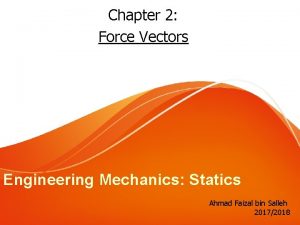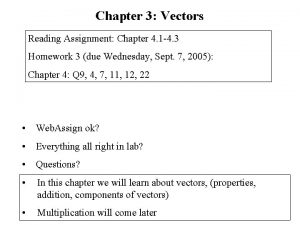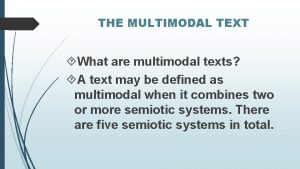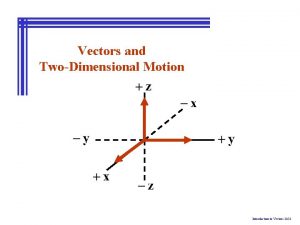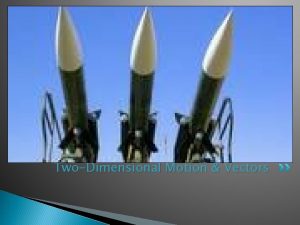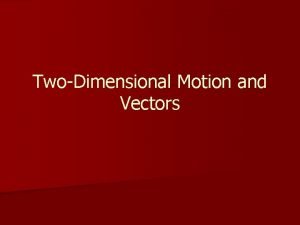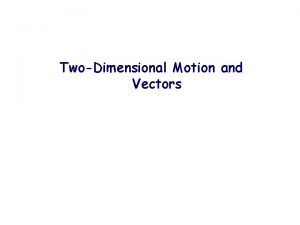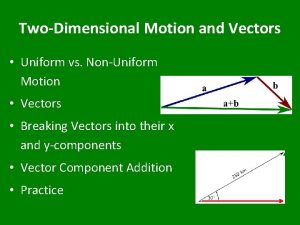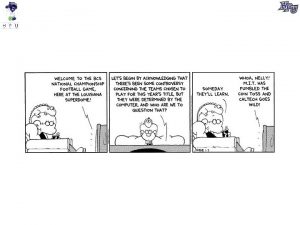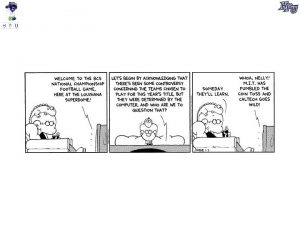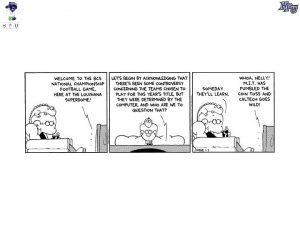TWODIMENSIONAL MOTION AND VECTORS INTRODUCTION TO VECTORS Chapter















- Slides: 15

TWO-DIMENSIONAL MOTION AND VECTORS INTRODUCTION TO VECTORS Chapter 3: Section 1

Learning Targets Distinguish between a scalar and a vector Add and subtract vectors by using the graphical method Multiply and divide vectors and scalars P 3. 2 A, P 3. 2 C

Reviewing Scalars and Vectors indicate direction while scalars do not A scalar is a quantity that has magnitude but no direction speed, volume, the number of pages in a textbook A vector is a physical quantity that has both direction and magnitude displacement, velocity, acceleration

Representing Vectors and Scalars Vectors are represented by boldface symbols while scalar quantities are represented by italics Velocity, which includes direction, is written v = 3. 5 m/s to the north The speed of a bird is written v = 3. 5 m/s You can also represent a vector by writing an arrow above the abbreviation for the quantity v = 3. 5 m/s to the north

Vector Diagrams Vector quantities are often represented by scaled vector diagrams. In vector diagrams, vectors are shown as arrows that point in the direction of the vector. The length of the vector arrow is proportional to the vector’s magnitude

Characteristics of Vector Diagrams 1. A scale is clearly listed 2. A vector arrow is drawn in a specified direction. The vector arrow has a head and a tail. 3. The magnitude and direction of the vector is clearly labeled.

Direction of Vectors The direction of a vector is often expressed as an angle of rotation of the vector about its “tail". For example, a vector can be said to have a direction of 40 degrees North of East This means the vector pointing East has been rotated 40 degrees towards the northerly direction

The direction of a vector can also be expressed as a counterclockwise angle of rotation of the vector about its “tail" from due East. A vector said to have a direction of 240 means that if the tail of the vector was pinned down, the vector was rotated an angle of 240 in the counterclockwise direction beginning from due east.

Magnitude of a Vector The magnitude of a vector in a scaled vector diagram is depicted by the length of the arrow.

Resultant Vectors When adding vectors you must make certain that they have the same units and describe similar quantities. Can’t add a velocity vector to a displacement vector Can’t add meters and feet The answer found by adding two vectors is called the resultant

Properties of Vectors 1. Vectors can be added graphically Imagine a toy car that is moving 0. 8 m/s across a walkway that moves at 1. 5 m/s forward The car’s resultant velocity while moving from one side of the walkway to the other will be the combination of two independent motions

The car’s resultant vector can be drawn from the tail of the first vector to the tip of the last vector. The magnitude can be measured using a ruler and the direction with a protractor

2. Vectors can be added in any order When two or more vectors are added, the sum is independent of the order of the addition Picture a runner training for a marathon along city streets In the picture below, the runner executes the same four displacements, but in a different order Regardless of the path, the total displacement is the same

3. To subtract a vector, add its opposite The negative of a vector is defined as a vector with the same magnitude as the original vector but opposite in direction. The negative velocity of a car traveling 30 m/s to the west is -30 m/s to the west, or +30 m/s to the east Adding a vector to its negative vector gives zero

4. Multiplying or dividing vectors by scalars results in vectors If a cab driver drives twice as fast, the cab’s original velocity vector (vcab) is multiplied by the scalar number 2. The result, written 2 vcab is a vector with a magnitude twice that of the original vector and pointing in the same direction Going twice as fast in the opposite direction would be -2 vcab
 Two dimensional motion and vectors
Two dimensional motion and vectors Chapter 2 motion section 1 describing motion answer key
Chapter 2 motion section 1 describing motion answer key Describing and measuring motion
Describing and measuring motion Section 1 describing motion answer key
Section 1 describing motion answer key Passive and active rom
Passive and active rom A 100 lb weight hangs from two wires
A 100 lb weight hangs from two wires Chapter 12 vectors and the geometry of space solutions
Chapter 12 vectors and the geometry of space solutions Harmonic equation physics
Harmonic equation physics An object in motion stays in motion
An object in motion stays in motion Section 1 describing motion answer key
Section 1 describing motion answer key Motion section 1 describing motion
Motion section 1 describing motion Chapter 2 representing motion
Chapter 2 representing motion Force vector r is having a
Force vector r is having a Chapter 3 vectors worksheets
Chapter 3 vectors worksheets What is the name of the quantity represented as i^?
What is the name of the quantity represented as i^? The multimodal text big ed mona
The multimodal text big ed mona












